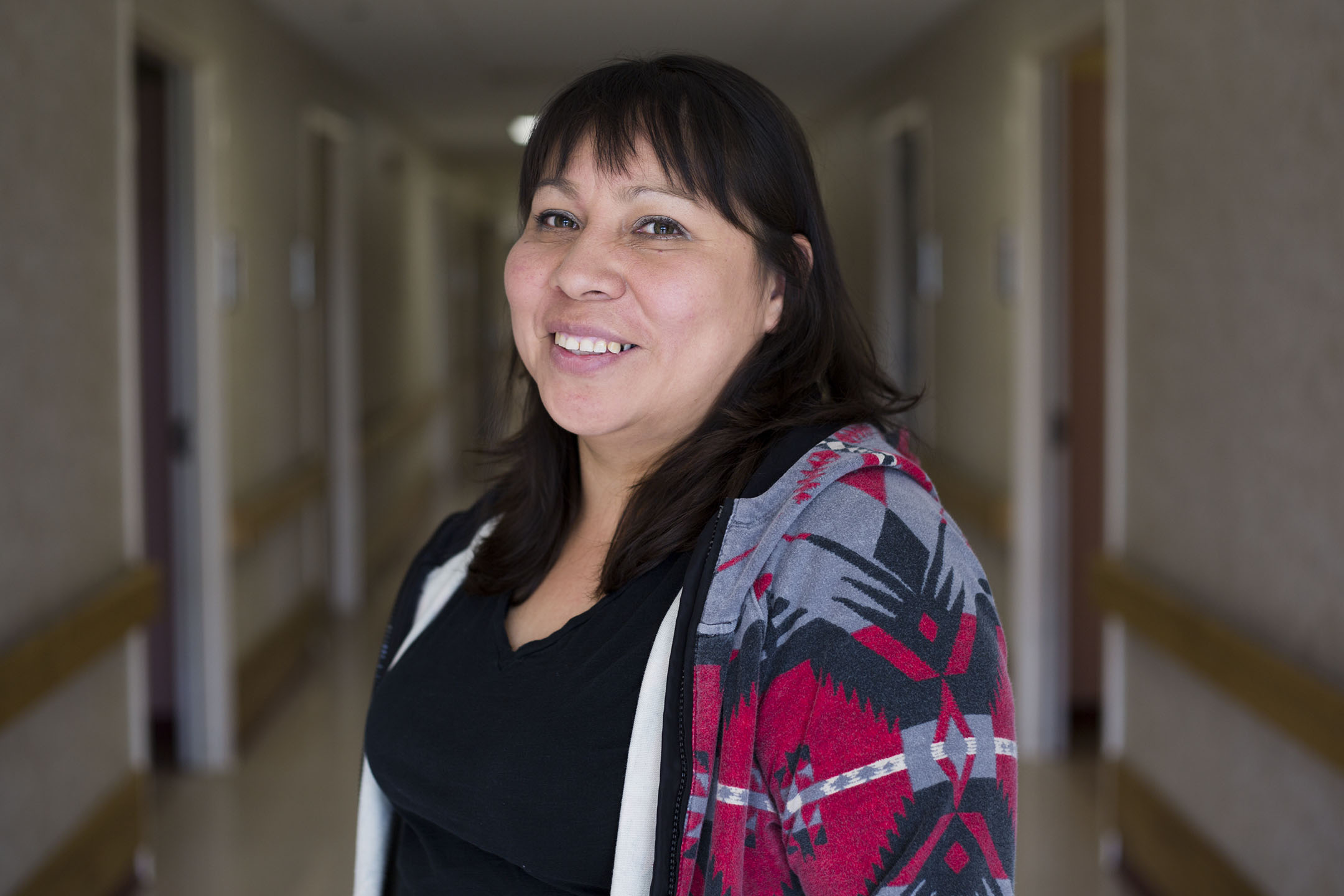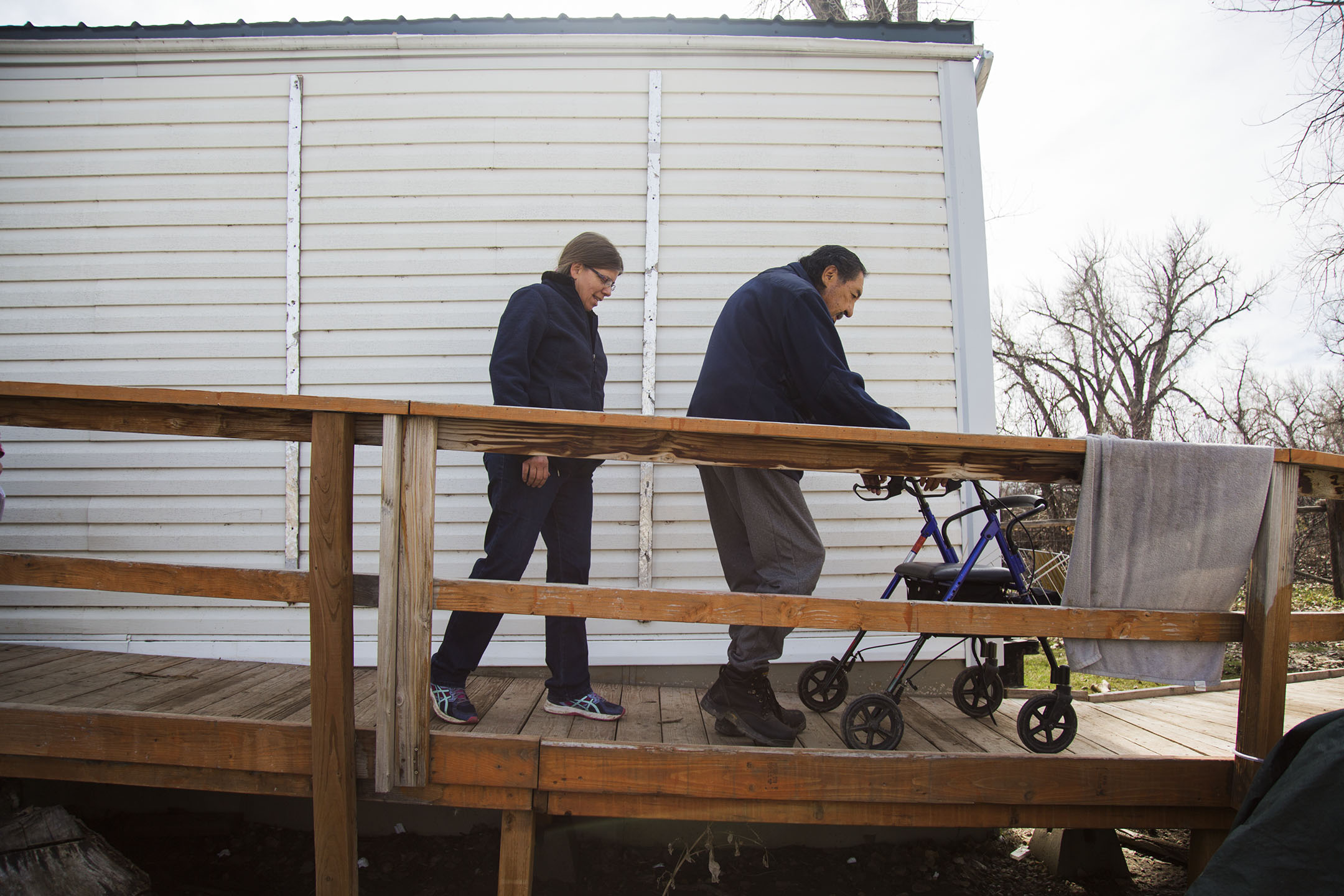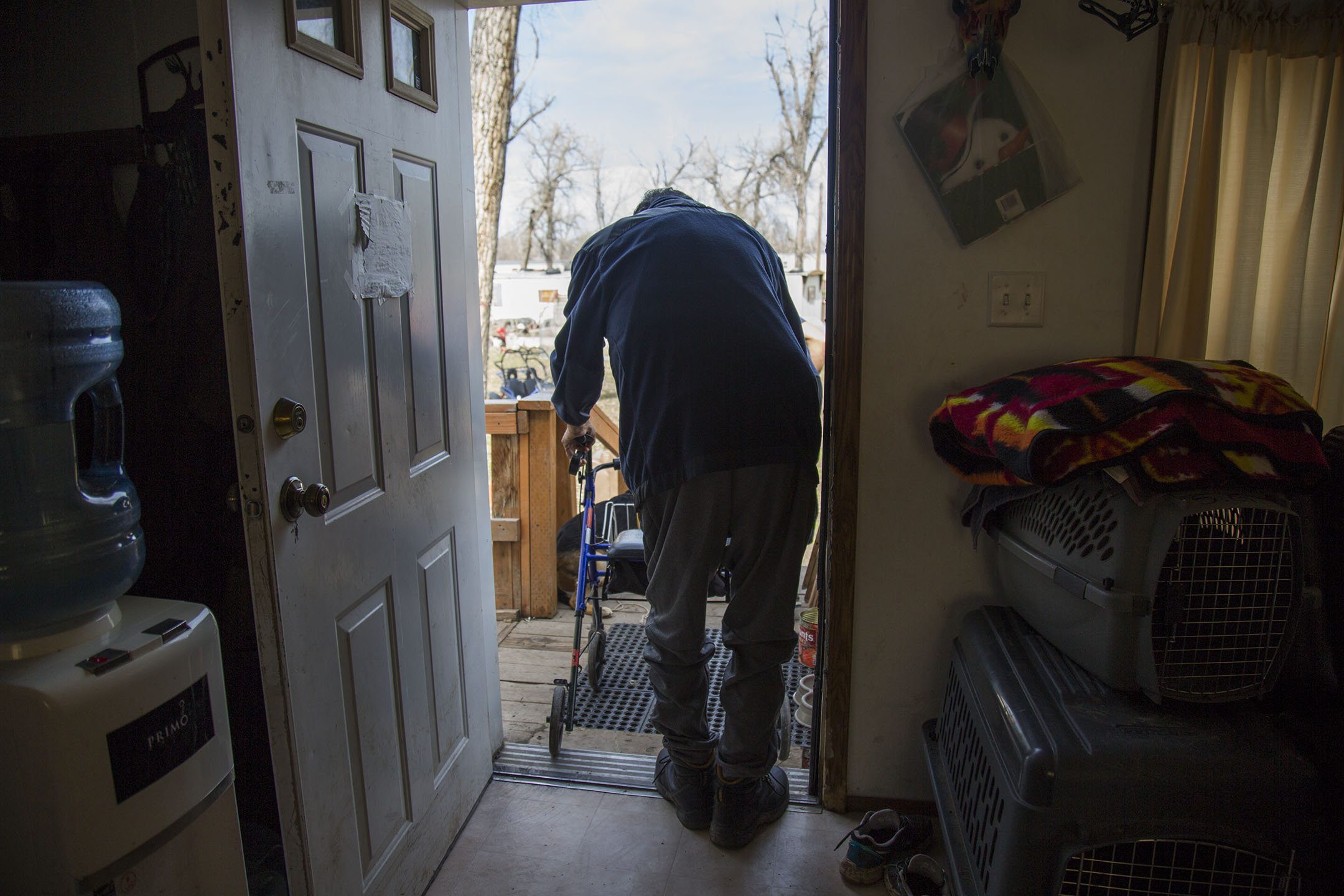Story by Olga Kreimer, photos by Olivia Vanni
When TroyLnn Shotgunn was 48 years old, she decided to give the nursing home a try.
It was more than a decade after rheumatoid arthritis forced her to leave her teaching job. Managing her health at her home had proven too difficult. Four times that year, Shotgunn ended up in the emergency room, immobilized and in pain while her medication lay forgotten in a drawer.
The second time, a doctor — recognizing a pattern — told her she might as well put a gun to her head.
“You’re supposed to take prednisone daily,” Shotgunn said. “When you drop it, you’re just asking for a heart attack or a stroke.”
She was scared. No one had explained it before. She vowed to take her medicine more regularly, but after every hospital visit she felt better, and within a couple of weeks she’d be off the regimen again.
Shotgunn’s mother, who together with Shotgunn’s son took care of her as the disease increasingly limited her mobility over the years, convinced her to try a nursing home.
The suggestion was alarming. Nursing homes were for the infirm, the elderly. They weren’t for people her age.
After her fourth ER visit, Shotgunn made the short move to Awe Kualawaache Care Center in Crow Agency. The Crow/Northern Cheyenne Hospital, where the ambulance dropped her off so often that year, is visible from its windows.
“I thought I’d gain strength and go home,” Shotgunn said. She gave herself a year to get her rheumatoid arthritis under control and to make it back home to her family. But after a year, she still wasn’t strong enough to go back to Busby. “RA had just taken over and taken a toll on me,” she said. “I thought it was just to throw their parents off where they don’t want to take care of them, but it’s not like that,” Shotgunn said. “Sometimes, they need more one-on-one care.”
Shotgunn is only 51 — but an even younger resident was staying at the home this spring.
Enlarge

Awe Kualawaache is the only nursing home on the Crow Indian Reservation. It also serves the neighboring Northern Cheyenne. In 2014, after more than a decade of contracted management by a Billings-based company called Health Management Systems, the Crow tribe took over nursing home operations directly.
Locals say the home is in better hands now. Its finances are in better shape, without relying on the tribal subsidy that supported it since its opening. Scores on annual state assessments of nursing facilities have improved. More of the staff is Native American now, which residents say makes them feel more at home.
Staff say that every resident at the center is covered by Medicaid, a joint federal and state program that helps with medical costs for low-income people. That’s different than Medicare, which pays medical expenses for people older than 65 or with certain disabilities but doesn’t cover basic long-term care in a nursing home. Medicare will only cover skilled nursing care.
As a skilled nursing facility, Awe Kualawaache is eligible for Medicare, but the center does not currently offer the therapy services required to bill the program, which includes speech, occupational and physical therapy.
For years, the center struggled to stay afloat on notoriously low Medicaid reimbursements. Now, the staff maps out the possibilities for expansion.
~-~
Administrator Carla Catolster worked at the center under the previous management as the only tribal member in the management staff. That experience, she said, convinced her that “somebody that sits in that chair needs to be from here.” She wants the center to be a refuge for its employees as much as for its residents.
Enlarge

She sees it as a calling, not just a job.
“These are our people,” she said. “We want to be able to do this for our people.”
Catolster is a Crow tribal member. Lesa Evers, a DPHHS Tribal Relations Manager and tribal liaison for Indian Health Service, said that is important.
“That’s a really big deal, to be able to have one of your members running a major part of your health service,” Evers said.
It’s also unusual. Awe Kualawaache is one of only two nursing homes in the state run by tribes, rather than contracted to outside management companies. The other is in Browning, on the Blackfeet reservation. IHS, which provides a range of medical services on five of Montana’s seven reservations, does not provide long-term care.
The transition to tribal management happened under the 1993 Indian Self Determination Act, a federal law that authorizes tribes to take over given parts of their administration from the federal government. The Confederated Salish and Kootenai Tribes on the Flathead reservation and the Chippewa Cree on the Rocky Boy’s reservation have used the program to fully administer their own tribal health programs.
The Crow tribe has owned Awe Kualawaache since it opened in 1998. However, Health Management Systems managed the site until 2014.
Todd Wilson, former director of the Crow Tribal Health Department, said the tribe was paying the Billings firm up to $25,000 a month for management services and to fill in budget gaps, and the administration was interested in less financially draining options. Health Management Systems President Karl Rude explained that Medicaid reimbursements simply didn’t cover all the costs, making continued management untenable.
Awe Kualawaache was the company’s last tribal contract, according to Rude. He said the frequent turnover of board members, who are appointed by the tribal chairman, made it difficult to maintain support for unpopular cost-saving measures, like layoffs.
In 2014, with a re-negotiation coming up, both the firm and tribal management were ready to end their contract.
~-~
By that time, Catolster said, the situation at Awe Kualawaache had deteriorated. The home, with 40 beds, was nowhere near capacity, and the center prepared letters instructing residents to move to other facilities after an annual state survey found multiple violations.
“They were getting tagged for pharmacy, medical visits weren’t getting done in a timely manner, nutritionists weren’t coming,” Catolster said.
Catolster was no longer the administrator by then. After working at the home since 2004, she was fired in 2013 after what she describes as years of employee rivalry and favoritism.
She had been the first Crow tribal member to successfully complete her nursing home administrator license and be promoted to the top role at the tribe’s nursing home. But now she let her license expire.
In 2014, the Awe Kualawaache board called Catolster back into action. Health Management Systems was gone, along with most of the management staff. She would have to rebuild nearly from scratch.
Drawing from her experience working in every department over the last decade, Catolster slowly got the center back up to speed, doing the billing and payroll herself in the beginning. Since the number of residents was low, revenue from Medicaid reimbursements covered just the payroll. Some vendors’ bills and the center’s tax obligations took a backseat for a time. The tribe was still contributing a monthly sum, which helped. Eventually, Medicaid approved an increase in per-patient, per-day reimbursement, which allowed the center to stop taking tribal funds.
Gradually, the center welcomed more residents. It paid the taxes owed and hired a full staff. These days, staff turnover — a major problem in rural medical facilities — is lower.
“Before, we had an orientation every month or every couple weeks,” Catolster said. “Now,” she paused, “we haven’t had one for a couple months.”
More of the staff is Native American these days, too. Catolster estimated 45 employees at the center, and she could think of only three who were not Native American. That’s a change she believes helps residents and staff alike.
As a resident, Evelyn Hogan-Bear Ground feels the difference. She’s related to several staff members at Awe Kualawaache. Hogan-Bear Ground moved to the center after a stint at the Heritage Living Center in Ashland, just east of the Northern Cheyenne reservation.
“I wanted to be with my own people,” she said. Here, the staff is “like family.”
~-~
About half of the center’s residents are Northern Cheyenne, like Shotgunn. She remembers the stricter days under the previous management and said she prefers the staff now. The Native American staff is more understanding and more lenient, she said. They have a good sense of humor. They chat and laugh with the residents.
“White people just do their job. They don’t add humor into it,” she said. She gets along with some anyway, but sometimes, “I just zip it and get what they’re gonna give me and get out.”
Awe Kualawaache Activities Director Yolanda Turnsplenty moved back to the Crow reservation last June after 25 years in Florida. At afternoon bingo, Turnsplenty joked with the residents pulling up chairs and rolling their wheelchairs around tables in the dining room. A television set was on mute in a corner, but all eyes are on cardboard game cards and Turnsplenty once the game starts.
Enlarge

Turnsplenty loudly announced the numbers to the room while also signing them for a resident at her table. Turnsplenty is working on opening her own graphic design business, but in the meantime she completed Certified Nursing Assistant training in November so that she could do more at the center.
Creating a nurturing home for residents is a priority for Catolster. Shotgunn appreciates the outings to shopping trips and summer rodeo visits, which keep residents connected to community life outside the home. Catolster prioritizes not just social activities or visits from a hairstylist every couple of weeks, but also staff mindfulness.
She remembered breaking up a loud argument between two employees one day, asking them, “You don’t go to somebody else’s home and fight, do you?” They said no, of course not. “This is their home. Their home,” Catolster emphasized. “We work in their home.”
~-~
But like any success story, this one has snags.
One is universal: There just aren’t enough nurses.
“There’s always a nurses’ shortage,” Catolster said. “It’s just a national problem. There aren’t enough nurses in the world.”
With the current nursing staff, Director of Nursing Jacinta Walks said that the center is about at capacity for residents. They have plenty of space; out of 40 available beds, 17 are empty. But the current resident-to-nurse ratio is already “pushing it,” Walks said. More patients, without additional nurses, would spread the care too thin. And more nurses are hard to come by.
The American Association of Colleges of Nursing estimates more than one million job openings nationwide by 2022. On the reservation, those problems are even more pronounced. Awe Kualawaache is in Crow Agency, a rural town of fewer than 2,000 people.
“A lot of times, when there’s somebody certified, IHS gets them,” Catolster said. She gestured out of the window in the vague direction of the neighboring hospital. “They get our nurses, they get our CNAs.”
IHS has better benefits, Catolster explained. It’s a more attractive package for employees in this rural corner of the state. Even IHS is perpetually understaffed, with high staff turnover and insufficient funding.
It’s a Catch-22. With more staff, Catolster could expand the center’s offerings to include rehab therapies, which are covered by Medicare and could bring in more patients and more funding. But to receive Medicare funds, she needs to have staff that’s trained in billing the program, which is more complicated than Medicaid.
Catolster is working on a contract with a company that specializes in bringing therapy services to rural areas, and she’s already trained three CNAs to assist in rehab. She hopes expanding the center’s services can help people stay closer to home.
Currently, many tribal members from the reservation end up in nursing homes in Billings to be near dialysis care, which is unavailable on the Crow reservation, Catolster said.
The typical length of a round trip between Awe Kualawaache and the clinic in Billings where residents get their treatment is about two hours. Since residents go in a group van, they have to wait until everybody is finished before turning back to Crow Agency. It’s a long trip and a long day. Some patients prefer to live farther away from the reservation instead of traveling that distance several times a week.
Local dialysis, assisted living and a home health program are part of the staff’s long-term vision. But more immediate problems require attention first.
“The building is old. Things are falling down,” said Catolster. Among them, her office ceiling, which was leaking for years and collapsed during heavy rains while she was out of town for a family emergency.
She has been borrowing computers while the office, gutted to its insulation, remains under construction. She wants to put in a new call light system, new bathtubs, new wheelchair lifts. She has already replaced the old manual beds with electric ones and started to improve the glitchy computer system, which was interfering with billing and payroll.
Catolster realizes that nursing homes are a last resort for people and for their families. Like Shotgunn, people want to stay in their homes, and families want to take care of their relatives.
“It’s hard to admit that you can’t take care of mom anymore,” Catolster said.
Medicaid is also invested in helping people stay out of long-term facilities. However, help with home care is hard to come by, and without help, many end up in Shotgunn’s position.
That’s the paradox that frustrates Patti Medicinehorse, a paramedic with Big Horn County Ambulance who cited community paramedicine as an answer to fill the gap between care at home, which families aren’t always equipped to handle, and inpatient care at a nursing facility.
Enlarge

Community paramedicine, she explained, is a program in which paramedics would be trained to offer a broader array of health services to rural residents. Big Horn County already has five employees with the necessary training; only funding is missing.
This is personal for Medicinehorse. She takes care of her husband, a Crow Sun Dance Chief who has Parkinson’s disease. Medicinehorse credits her medical training for her ability to provide the care he needs full-time, but those without trained family members or extra help are often forced to look elsewhere.
Non-medical support, like Meals on Wheels and free meals at the Senior Citizens’ Center, provide community and a point of access to social services when needed, but regular medical help like the kind that could have helped Shotgunn is unavailable.
~-~
A year after she moved to Awe Kualawaache to try it for a week, Shotgunn finally decided to decorate her room to make the center feel like home. Now, Shotgunn’s walls are covered in paintings by her grandson, photos of her grandchildren and a completed puzzle by her best friend in the home, who passed away last year. The bubblegum pink vanity and wardrobe match her brightly coordinated outfits, down to her socks and her Crocs.
Shotgunn’s father moved in a few months ago, too. It was weird at first, she said, especially when her dad would come to her room and tell her she should be up already on mornings when her arthritis kept her in bed. But eventually, “it just got to be normal.”
Shotgunn still misses home, especially going outside at night when everything is still and peaceful. Here, the doors are locked after 10 p.m., but it’s not the same anyway, with trains and semis on the nearby highway interrupting the night.
“I miss listening to the quiet town of Busby,” Shotgunn said. But her dad is down the hall, and her grandkids smile down from the wall. She thinks she might go back to Busby one day with the help of her son and daughter, who she thinks could get training in how to help her get around.
If she were in Busby, she might sit out at night, listening to the quiet outside her door. But for now, this is home.
For past Native News editions visit the archive here.










